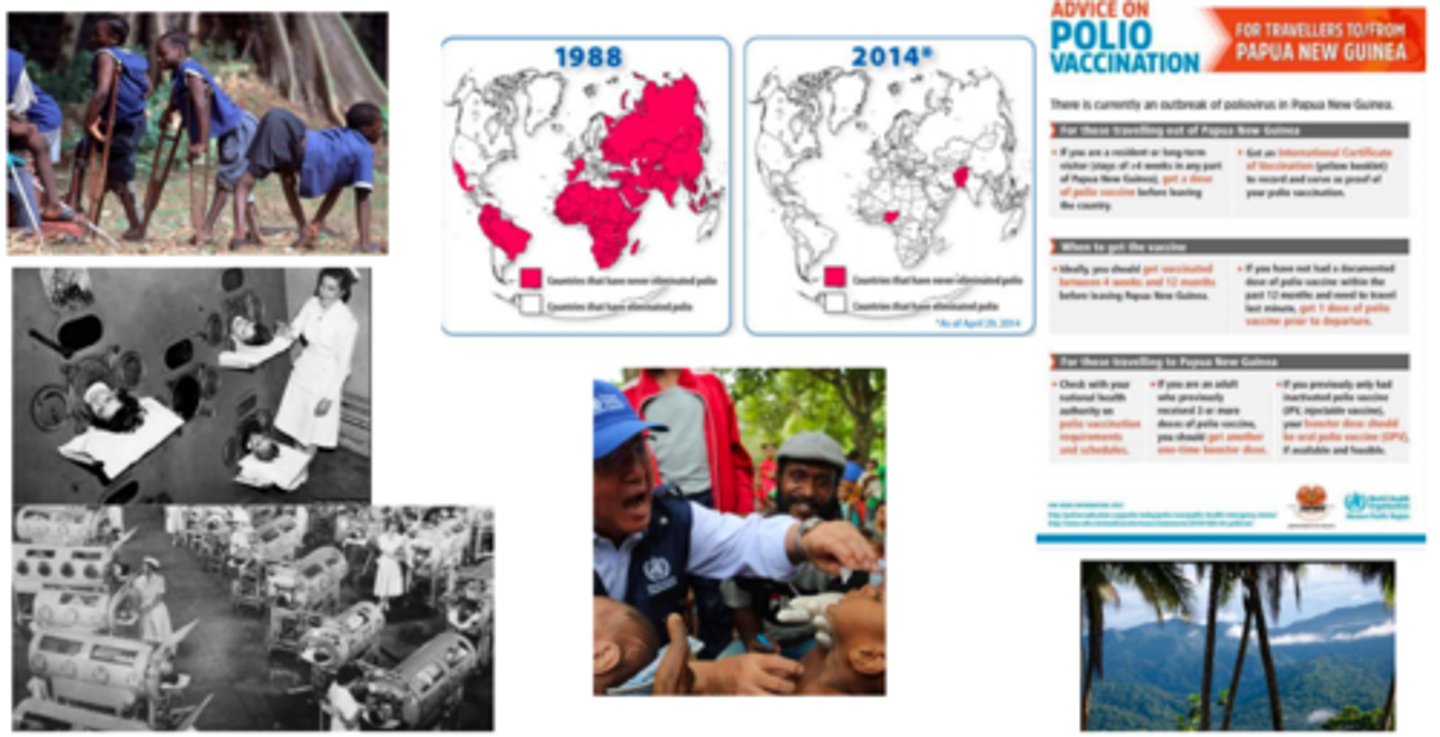acute viral infections
1/25
There's no tags or description
Looks like no tags are added yet.
Name | Mastery | Learn | Test | Matching | Spaced |
|---|
No study sessions yet.
26 Terms
how are acute viral infection characterised and give examples of disease
• Acute viral infection is characterized by rapid onset of disease, a relatively brief period of symptoms,
and resolution within days
• Infectious virions are usually produced early in the course of disease
• Host immune response eliminates infection
eg rhonovirus, rotavirus, influenza virus
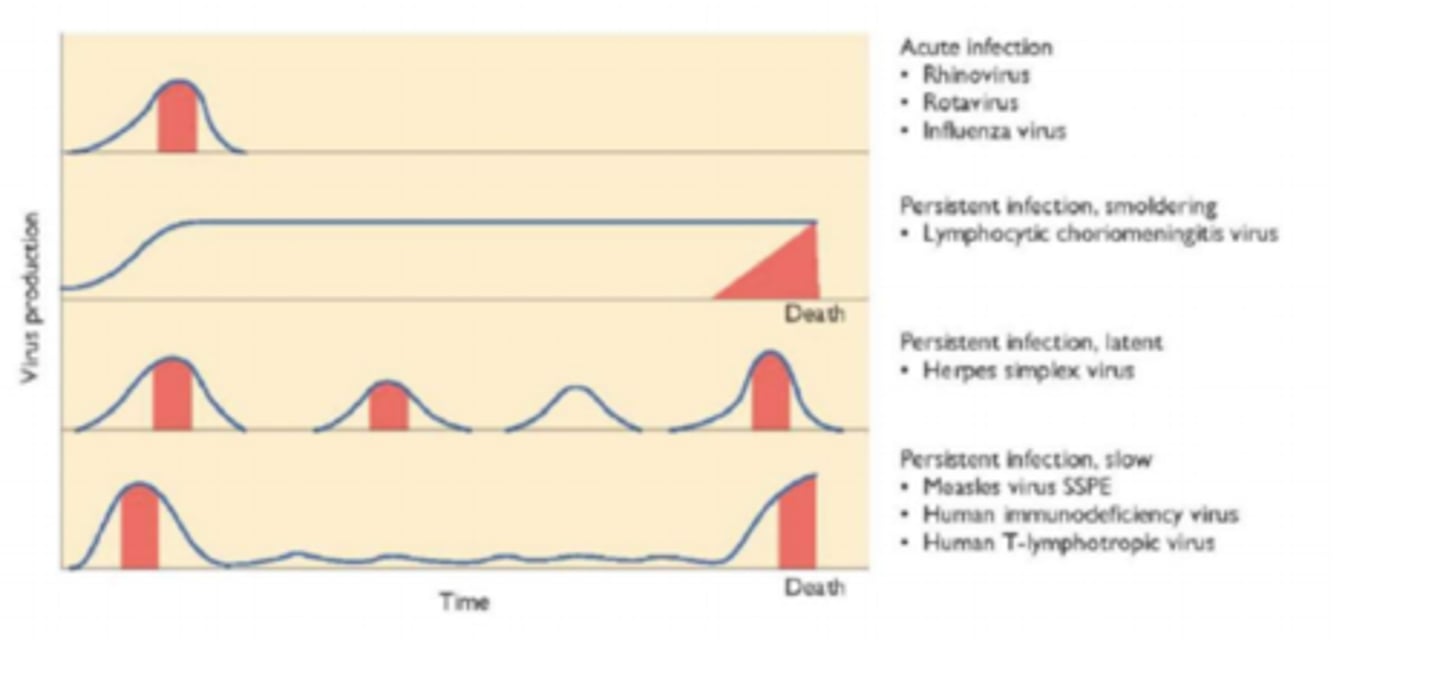
common public health problems and acute infections
- acute infections are often associated with serious epidemics affecting millions of ppl
- infected host is often infectious before symptoms manifest
- by the time the host is sick enough to stay home ('social isolation') , away from susceptible new hosts, transmisson have already occurred
- Such infections are very difficult to control in large populations or crowded environments ( eg nursing homes, day care centres, schools, offices)
- effective antiviral therapy requires treatment early in infection- most often initiated too late in disease course
zika virus disease symptoms and transmission
symptoms
- fever
- rash
- joint pains
- conjunctivtis
transmission
- person infected with Zika virus
- possible transmission from mother to baby during pregnancy
- aedes mosquito bites infected person
- infected mosquito bites another person and transmits virus
Re-emergence acute viral infection
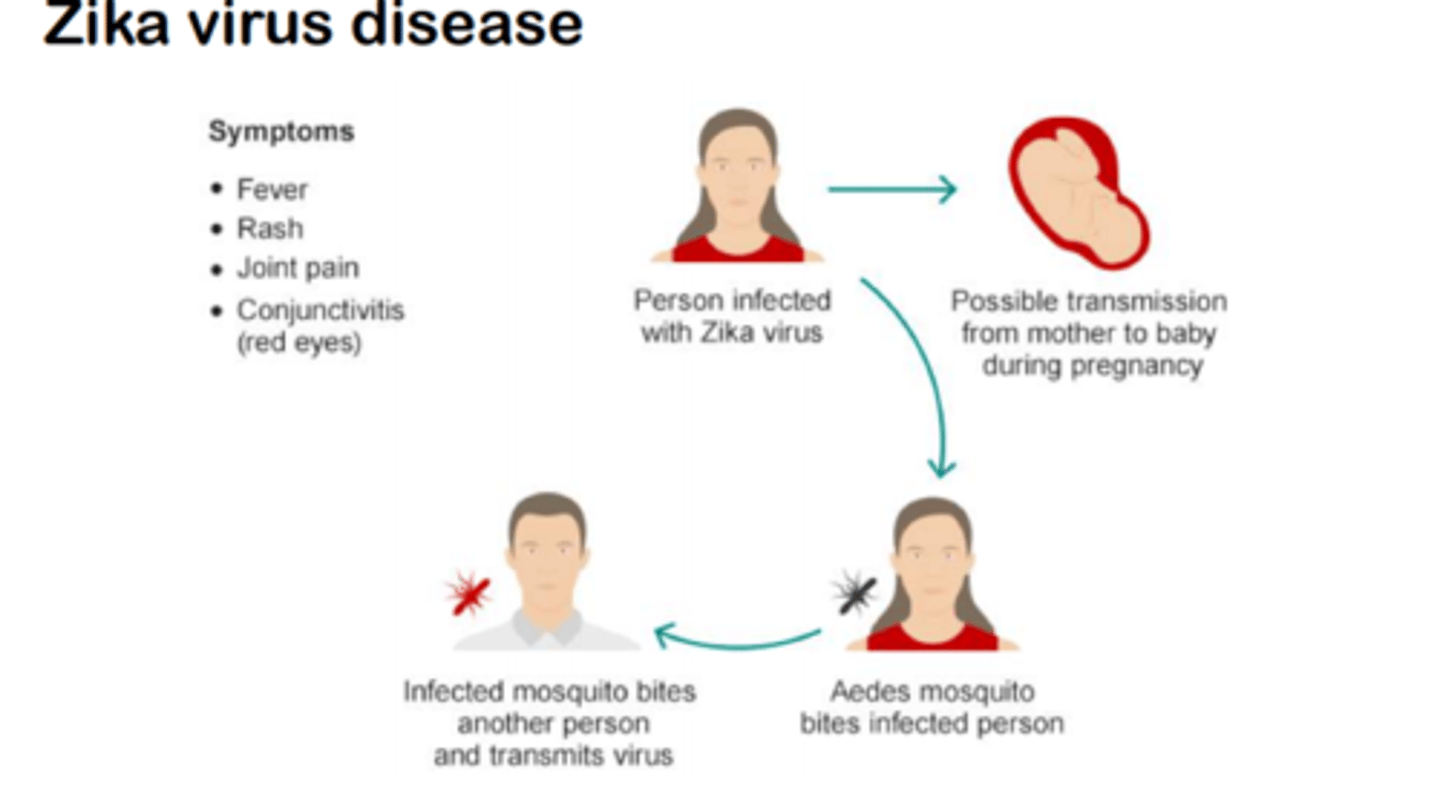
history of zika virus
Zika virus was discovered in Uganda in 1947
• A sentinel rhesus monkey - monkey #766 -
placed in a cage in the canopy of the Zika
Forest became ill on April 18, 1947
• Blood from monkey #766 caused disease in
mice; virus was recovered from the brains of these mice
• Extracts from Aedes africanus mosquitoes trapped in the Forest in January 1948 caused
disease in mice; monkeys were infected with mice brain extracts (and subsequently
infected mice)
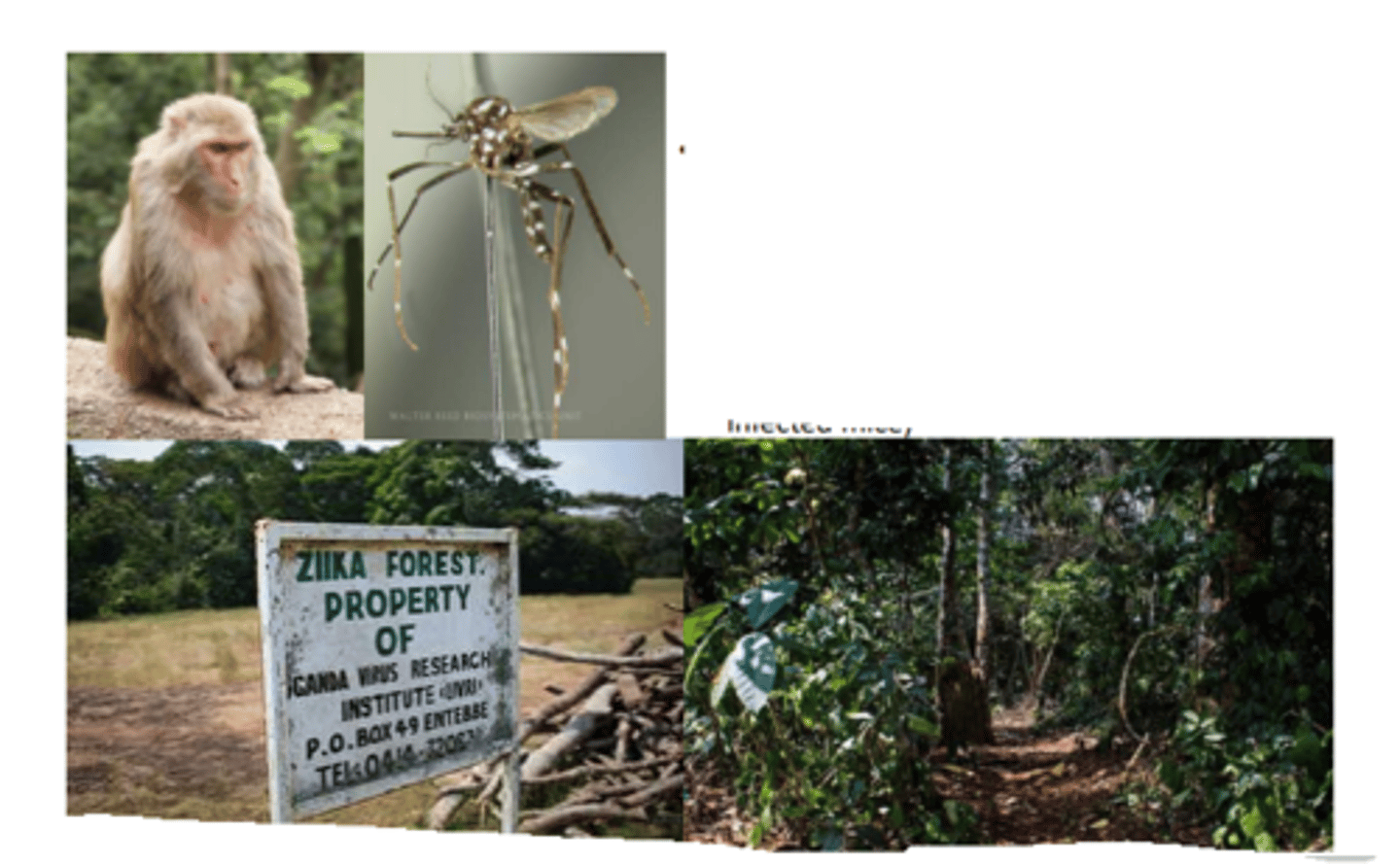
Zika, French Polynesia 2013
• October 2013: patients from same family presented with
'dengue-like illness'
v Low fever; arthralgia; headache; rash; conjunctivitis; apthous ulcers
• Two weeks later, another patient with similar symptoms
• FP MOH reported increase in symptoms of patients
visiting clinics with dengue-like illness
• 7 weeks after presentation of first family, 19,000
cases reported
• Estimated 30,000 cases (11.5% of population)

Guillan-Barré syndrome French Polynesia 2013
• French Polynesia reported an unexpectedly high number of GBS cases occurred during the Zika outbreak • Established incidence prior to 2013 was 1-3 cases per 100,000 inhabitants per year - 42 cases were reported during the ZIKV transmission period in 2013, a 20- fold increase
• All cases developed GBS following a 'Zika-like syndrome
post viral infection syndrome
neurons targeted by immune response after the infection has cleared

microcephaly among newborns( Brazil 30 october 2015)
causes
Microcephaly is a neonatal malformation defined as head size much smaller than
other babies of the same age and sex
A very rare condition; most common known causes are
• infection in-utero with toxoplasmosis, rubella, herpes, syphilis, HIV, CMV
• Exposure to toxic chemicals such as arsenic and mercury, alcohol
• Genetic abnormalities such as Down's syndrome
• Severe malnutrition during fetal life

when did the WHO declared that zika was a public health emergency?
1 February 2016
orld Health Organization declares that the recent association of Zika
infection with clusters of microcephaly and other neurological disorders
constitutes a Public Health Emergency of International Concern
emergence of zika in mid 2016
Emerging evidence for a broad range
of possible complications for babies born to
women infected with Zika viru
s
Effects on other brain abnormalities, apart from microcephaly
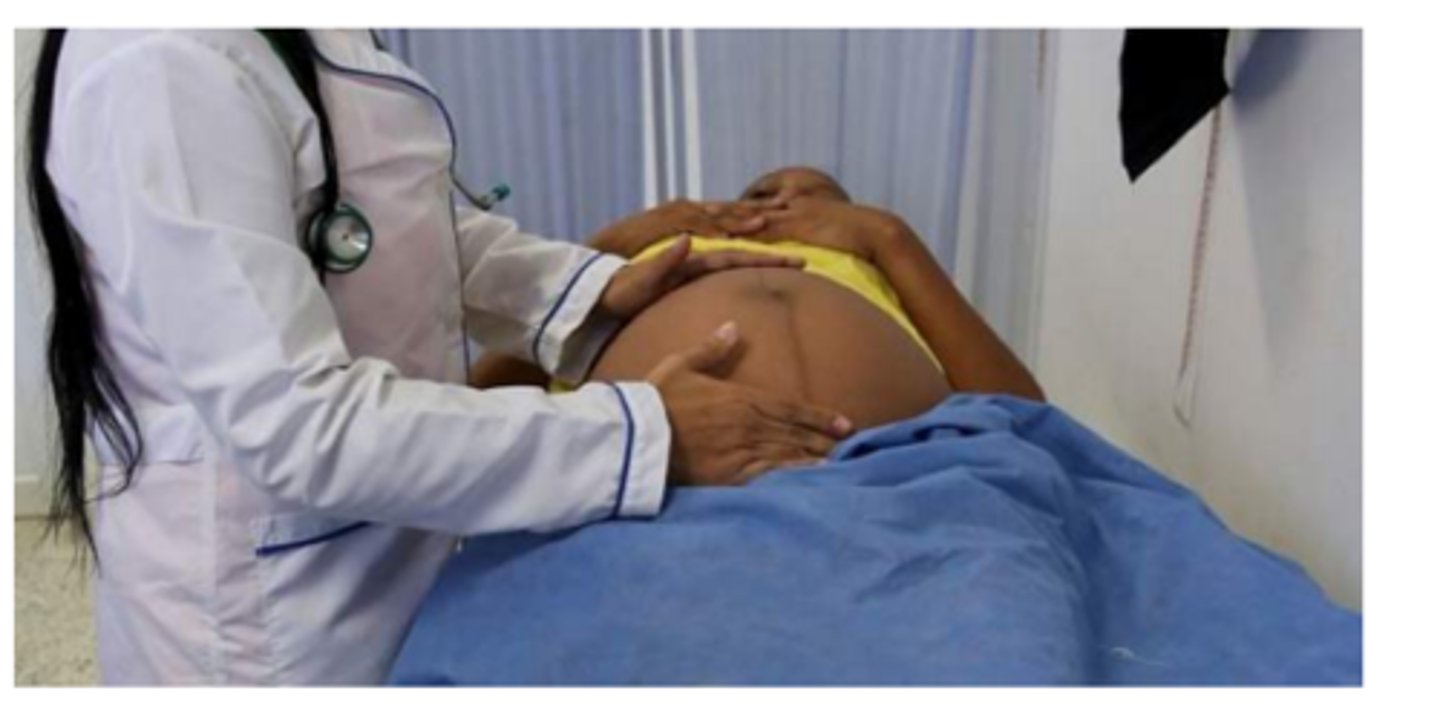
Respiratory Virus Infections
( common infection, symptoms, who is affected, complications)
• Common viral respiratory diseases are caused by a variety of viruses - influenza,
respiratory syncytial virus, parainfluenza virus, adenoviruses - that cause upper
respiratory tract infections
• Characterised by fever, chills, headache, body ache, weakness, loss of appetite
• Some viruses cause more severe illness and/or more commonly affect certain age
groups - children develop bronchiolitis, pneumonia, croup, bronchitis, otitis
media
• Symptoms appear 1-10 days after exposure; infection without complications will
subside in 2-5 days
• Bacterial complications may follow - otitis media, pneumonia, sinusitis
• Antiviral compounds are available for some viral infections, but must be
administered early to be effective
likelihood of transmission ( bodily fluids, droplet, fomite)
bodily fluid contacts ( high)
droplet
fomite
aerosol
fomite= inanimate object or substance that is capable of transmitting infectious organisms eg dust particles
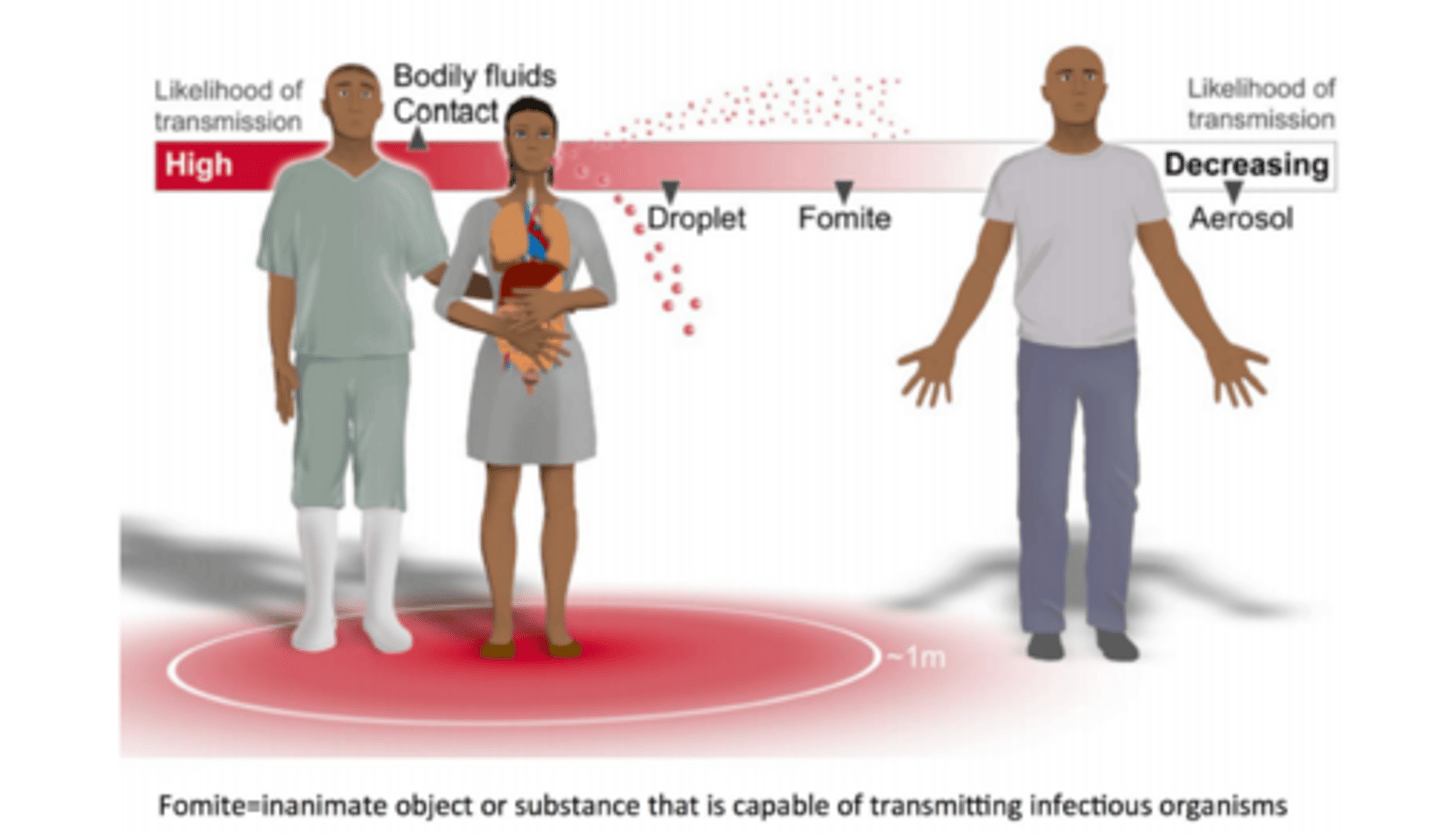
LRT infections
- major acute viral infections of the lower respiratory tract are cuased by
- influenza virus
- respiratory synctial virus
- common characteristics of infection are
- short incubation period of 1 to 4 days
- transmission from person to person
- transmission can be direct or indirect
- direct: through droplets
- indirect: through hand transfer of contaminated secretions
influenza (acute viral infection) of public health importance
- influenza is caused by orthomyxoviridae
- myxo: Greek word for mucous: IV can attach to mucoproteins on cell surface
- 3 genera which can infect humans
- influenza virus A [H1-18; N1-11]
-influenza virus B [B/Yamagata, B/Victoria]
- infleunza virus C ( mostly in appparent, or mild, URTI)
- IVA undergoes genetic shift and causes pandemics
- minus sense ssRNA virus which can undergoes mutation adn reassortment: high rates of antigenic variation
- most recent pandemic started in 2009: H1N1
![<p>- influenza is caused by orthomyxoviridae</p><p>- myxo: Greek word for mucous: IV can attach to mucoproteins on cell surface</p><p>- 3 genera which can infect humans</p><p>- influenza virus A [H1-18; N1-11]</p><p>-influenza virus B [B/Yamagata, B/Victoria]</p><p>- infleunza virus C ( mostly in appparent, or mild, URTI)</p><p>- IVA undergoes genetic shift and causes pandemics</p><p>- minus sense ssRNA virus which can undergoes mutation adn reassortment: high rates of antigenic variation</p><p>- most recent pandemic started in 2009: H1N1</p>](https://knowt-user-attachments.s3.amazonaws.com/37f1c032-7d3d-4d9e-a3d0-c96769ba5a41.png)
what are the clinical features of influenza
- incubation period of 2-3 days ( this is variable and depends on host susceptibility, and dose)
- abrupt onset of febrile illness ( 38-40 deg C) w shivering, malaise, headache, achin in limbs and back. Patient is characeristically prostrated
- not characterized by runny nose or sore thriat
- severity is generally proportional to age : short lived in young ppl ( except babies, who are at risk of complicated influenza); recovery in old ppl can take 3-6mnths
- IVA and IVB are clinically similar
- secondary bacterial infection w Streptococcus pneumoniae may be life threatning'
- Reye's syndrome is a complication seen ( rarely ) in chuldren ( encephalopathy w fatty degeneration of liver and other organs), often fatal
what is the difference between seasonal, avian, swine and pandemic influenza
Seasonal ( common influenza)
- a respiratory illness transmitted person-to-person
- most ppl have some immunity + vaccine is availabel
avian ( bird flu)
-influenza viruses that occur naturally among wild birds. ther eis no human immunity and no vaccine
- The H7N9 subtype is the current concern
Swine ( swine flu)
- respiratory disease of pigs caused by IVA that regularly causes outbreaks of influenza in pigs. Do not normally infect humans, but sporadic human infections occur, designated as 'variant viruses' such as H1N1v
pandemic influenza
- a virulent human influenza that causes a global outbreak, or pandemic, of serious illness. There is little natural immunity, thus easy person t person transmission
swine influenza ( transmission, vaccines )
- swine influenza viruses circulate in pigs throughout the year
- seasonal outbreaks occur, similar to what happens in humans
- swine flu viruses dont normally infect humans
- sporadic human infections w swine influenza have mostly occurred in ppl exposed to infected pigs
- vaccines against human IV will not protect against swine influenza viruses that are infecting humans
- pigs are susceptible to avian, human and swine IV and reassortants can emerge which are novel viruses

genetic reassortment and antigenic shift among influezna A virus
genetic reassortment
antigenic shift and pandemics
no immunity in humans against new IVA HA proteins on virus surface
- pandemics are caused by new IVA that have evolved by antigenic shift
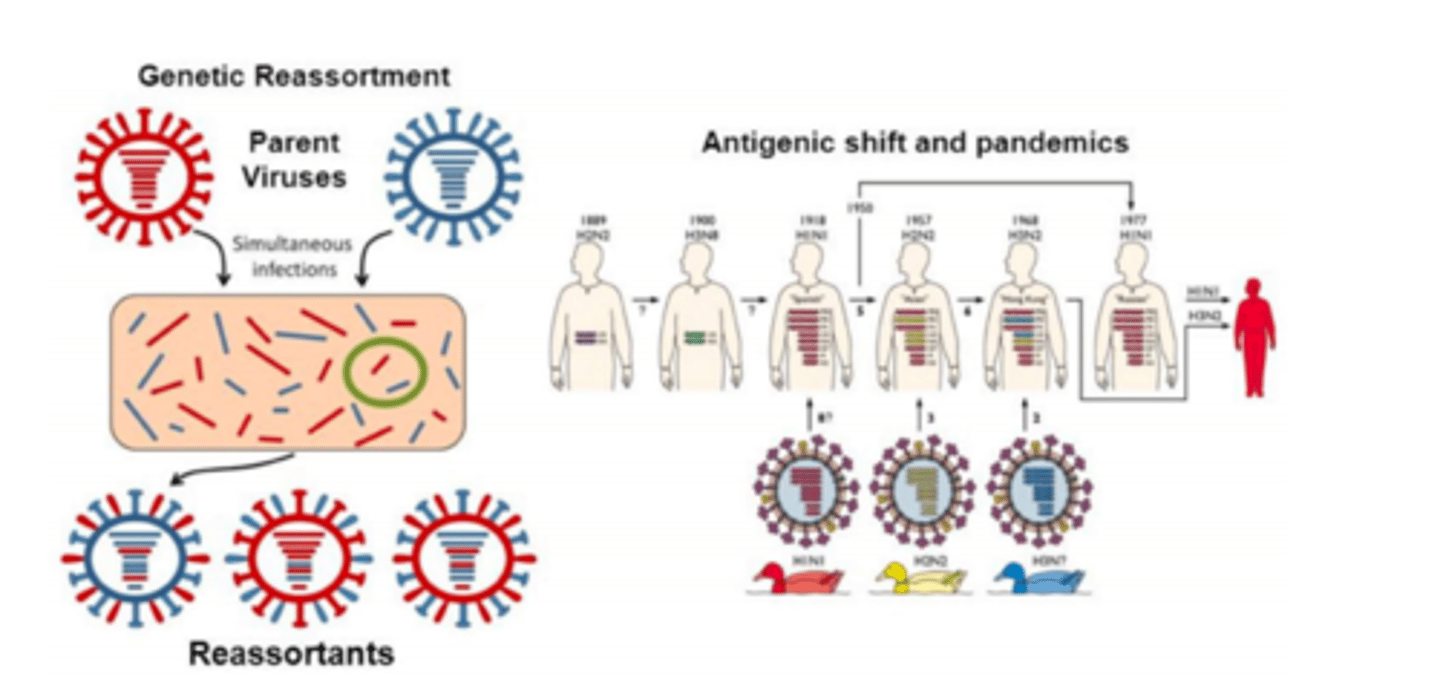
sars-cov-2 and covid 19
- zoonotic virus, natural host= vertebrates; animal reservoirs- bats
- cell receptor ACE2
- respiratory transmission
- primary site of infection: epithelial cells of respiratory or enteric tracts
- secondary sites: kidney, heart tissue
RNA virus so genome continually has errors as it replicate
but it has a proofreading mechanism
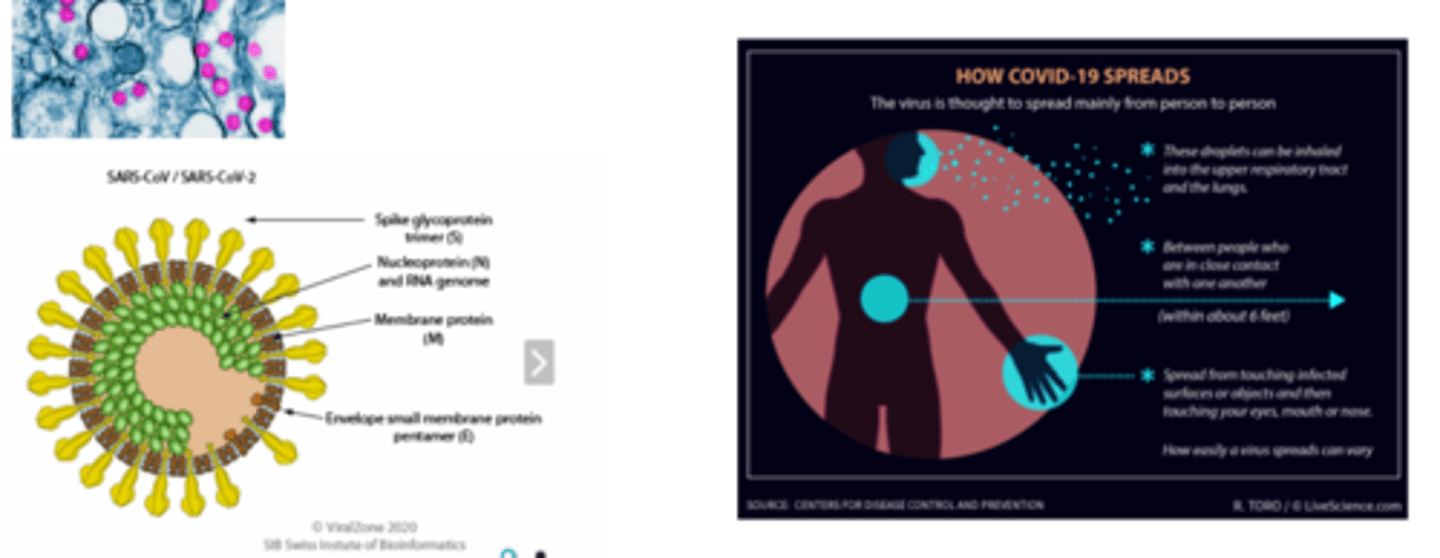
describe Immune response to SARS‐CoV‐2 and mechanisms of immunopathological changes in COVID‐19
-innate immune response has not been able to block this infection
- Virimia incereases and becomes symptomatic
- Replication of RNA is advancing
- igM developed and declines. Class swithcing to igG. igA also seen as it is a mucosal infection
- Most ppl, viral particle declines to 0
In immunocompromised patients, viral particles detected for a v long time
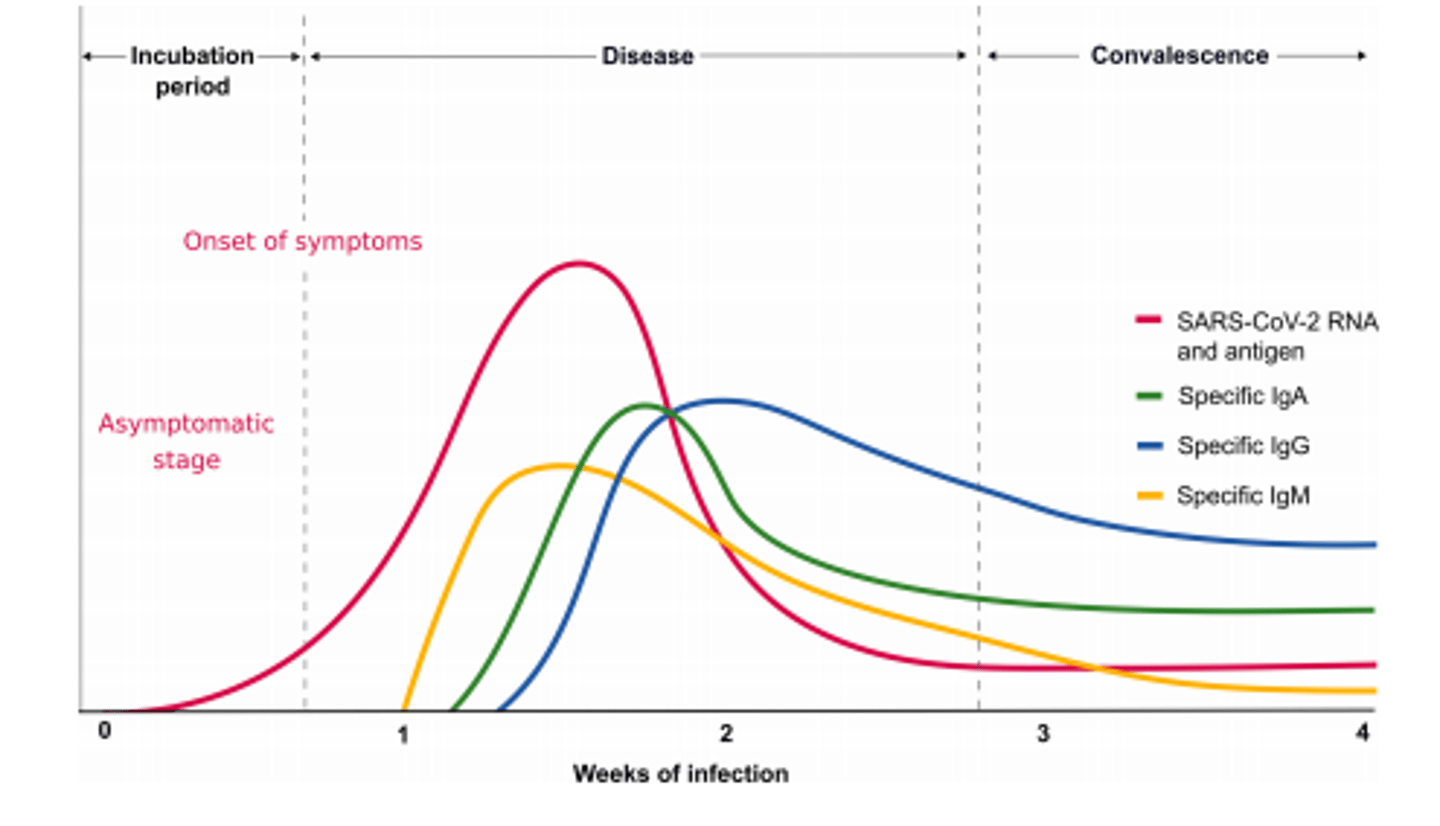
SARS-CoV-2 and COVID-19 ARDS and risk factors for mortality
ARDS ( acute respiratory distress syndrome)
- significant trauma- including viral infection- to lung tissue that induces a dysfunctional inflammatory reaction
- small blood vessels become leaky, fluid moves into alveoli, oxygenated becomes depleted
risk factors for COVID-19mortality
- older age
-higher sequential organ failure assesment (SOFA) score
-elevated d-dimer levels
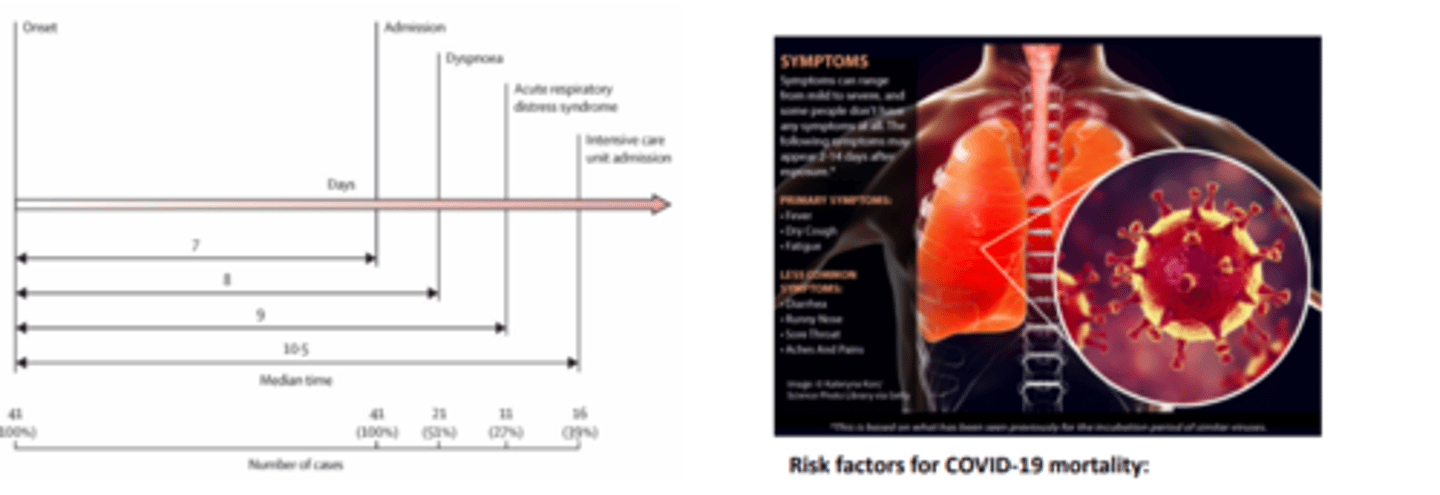
how does viral infection affects CNS
most represent uncommon complications of common systemic infections
aseptic meningitis ( causes, cell count, symptoms, type of virus)
illness characterised by inflammation of meninges, usually with accompanying mononuclear pleocytosis ( increased mononuclear cell count; normal CSF contains 0-5MNC). not caused by pyogenic bacteria
- viral infection is most common cause of aseptic meningitis; enteroviruses are most common viral cause
- there are also noninfectious cases of aseptic meningitis, however, term is alsmost synonymoys w viral meningitis
symptoms: headache, fever, some cases can be severe and life threatning
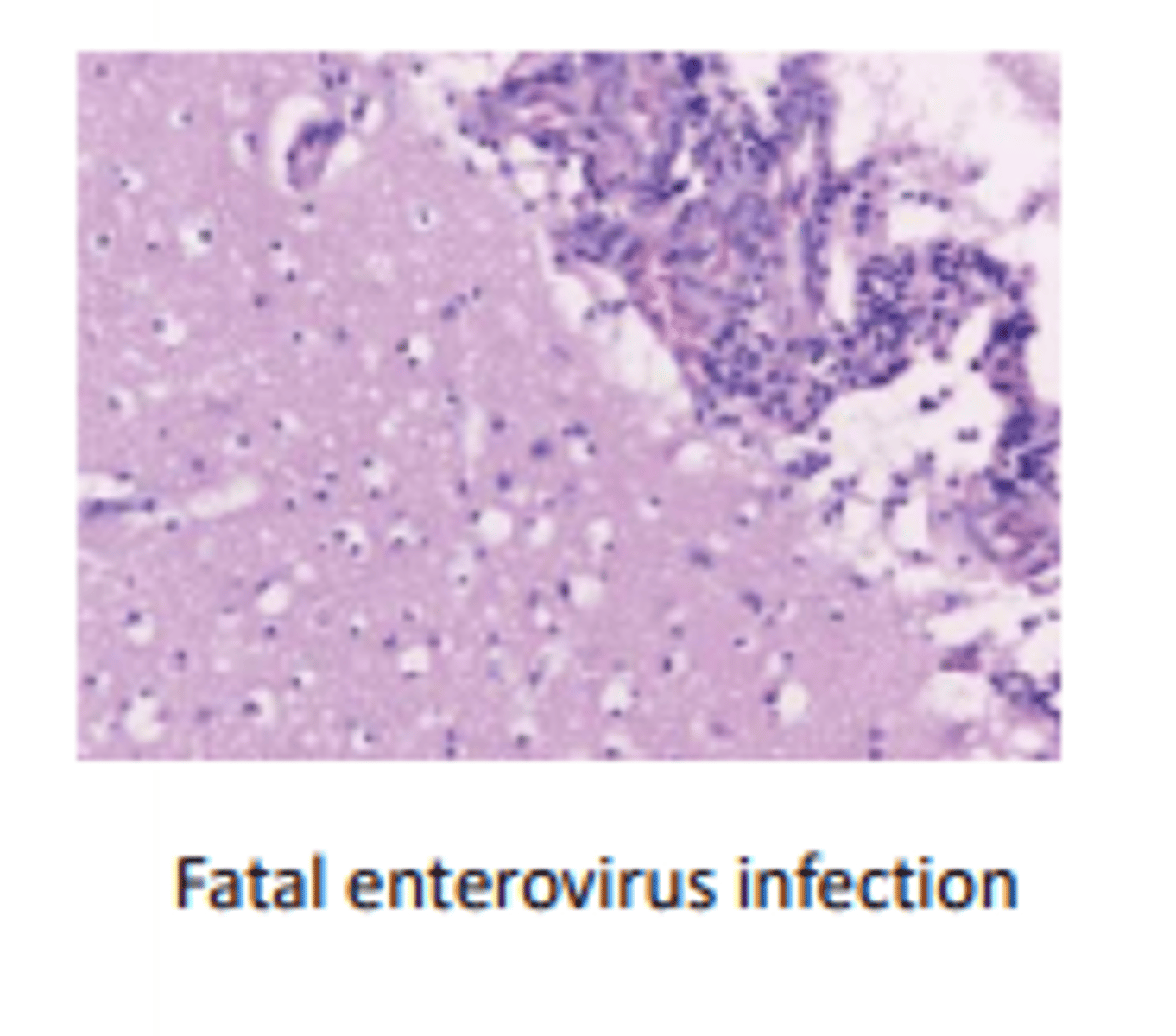
encephalitis ( symptoms, virus type)
infection of brain
-myelitis refers to inflammation of the spinal cord; when both brain and spinal cord are involved, condition is called encephalomyelitis
- encephalitis w meningitis is called meningoencephalitis
symptoms: headache, fever, confusion, drowsiness; more advanced disease include convulsions, seizures, hallucniations, memory loss
-viral encephalitis may be direct effect of acute infection, or a complication of latent infection
- most diagnosed viral encephalitis caused by enteroviruses; HSV types 1 and 2 ; rabies virus; arboviruses
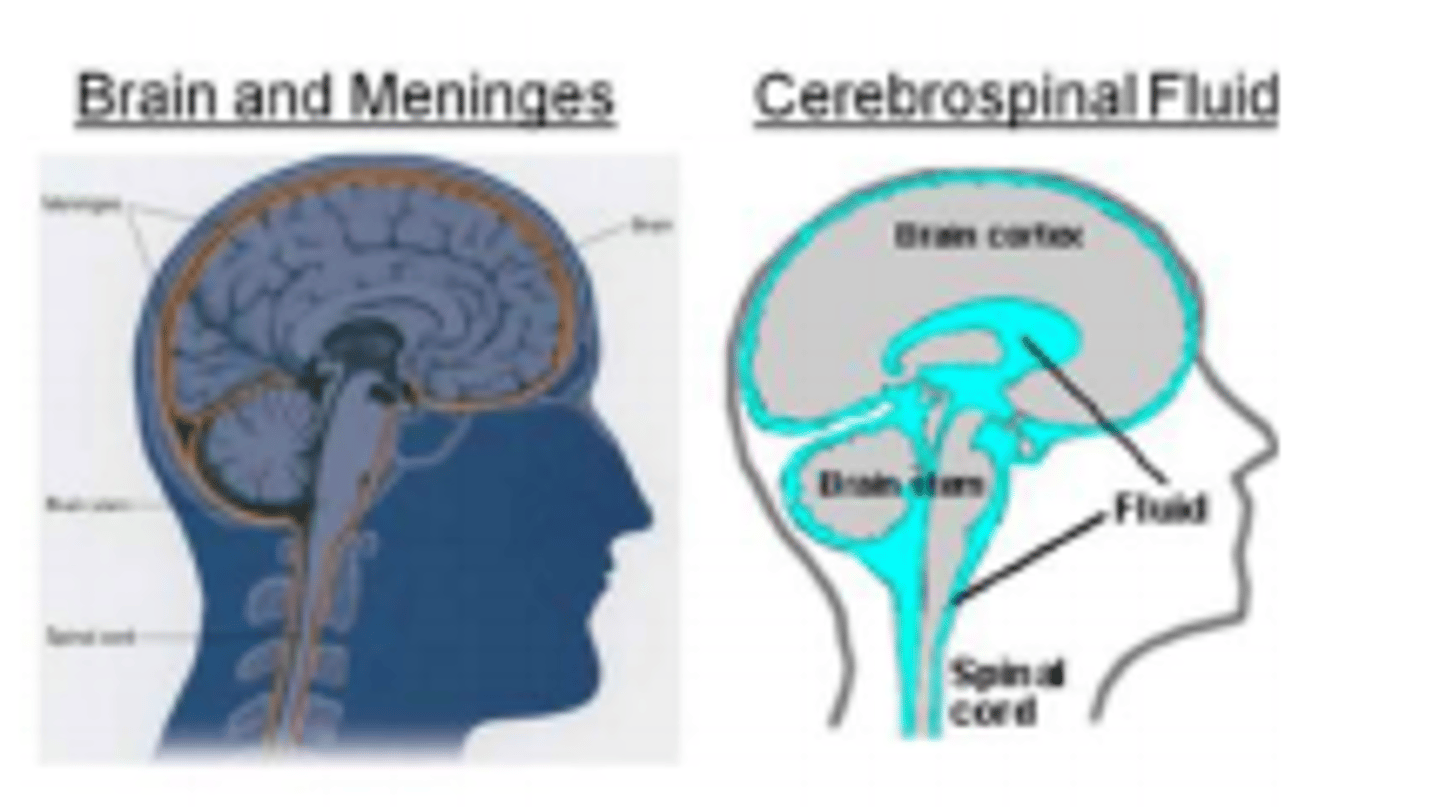
acute flaccid paralysis ( site of infection, virus type, effects)
acute onset of flaccid paralysis in one or more limbs
- may be caused by anterior horn cell infection w wild or vaccine polio virus, or other viruses. eg Enterovirus 71
anterior horn of spinal cord contains bodies of motor neurons, which put brain's decisions- based on sensory info ( from dorsal root ganglia)- into action. damage to anterior horn cells affects muscle movements
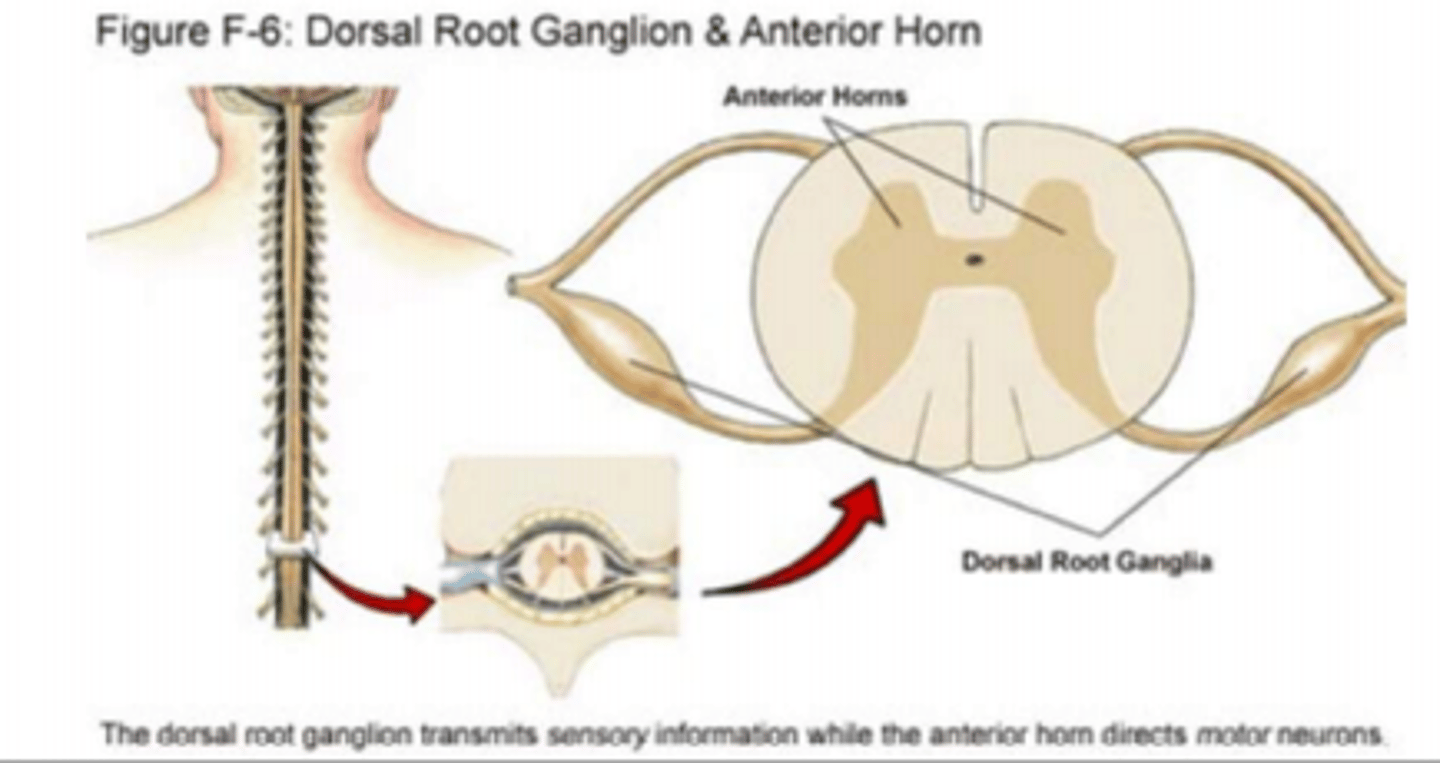
Polio ( what cells in infect, symptoms, effect)
-polioviruses infect mucosal cells in oropharynx and intestine, multiply in number and shed in throat and feces, some leak into blood
- most infections are short-term, mild viremia
- some patients develop mild nonspecific symptoms of fever, headache, nausea, sore throat and myalgia
- if viremia persis, virus spreads to spinal cord and brain
- if nervous tissue is infected but not destroyed- muscle pain and spasms, meningeal inflammation, and vague hypersensitivity
- invasion of motor neurons causes flaccid paralysis
- decades later post-polio syndrome (PPS)- progressive muscle deterioration occurs in 25-50% of patients infected w poliovirus in childhood
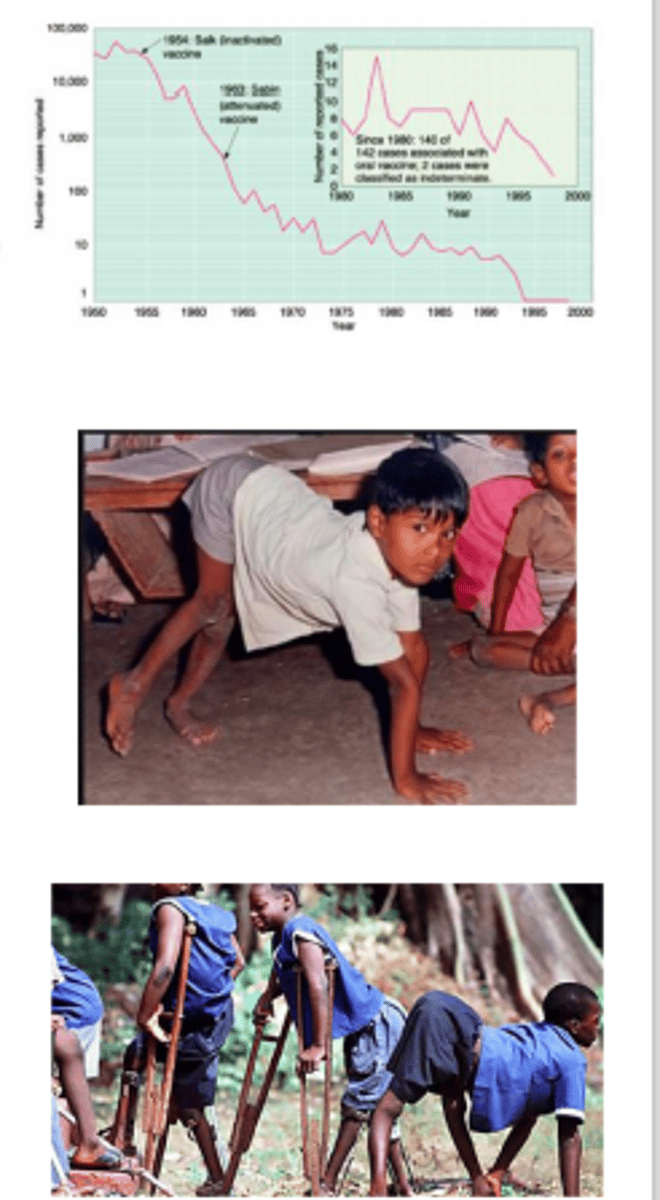
what is the next disease targeted for
eradication
polio
